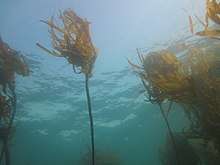Nereocystis
Nereocystis (Greek for "mermaid's bladder") is a monotypic genus of kelp containing the species Nereocystis luetkeana.[1] Some English names include edible kelp, bull kelp, bullwhip kelp, ribbon kelp, bladder wrack, and variations of these names.[2] Due to the English name, bull kelp can be confused with southern bull kelps, which are found in the Southern Hemisphere.[3][4] Nereocystis luetkeana forms thick beds on rocks, and is an important part of kelp forests.
| Nereocystis | |
|---|---|
 | |
| Nereocystis luetkeana at Caspar Point, California | |
| Scientific classification | |
| Kingdom: | Chromista |
| Phylum: | Ochrophyta |
| Class: | Phaeophyceae |
| Order: | Laminariales |
| Family: | Laminariaceae |
| Genus: | Nereocystis Postels & Ruprecht |
| Species: | N. luetkeana |
| Binomial name | |
| Nereocystis luetkeana (K.Mertens) Postels & Ruprecht | |
Etymology
The species Nereocystis luetkeana was named (as Fucus luetkeanus) after the German-Russian explorer Fyodor Petrovich Litke (also spelled Lütke) by Mertens. The species was renamed in a description by Postels and Ruprecht.[5]
Description

Individuals can grow to a maximum of 36 m (118 ft).[6] Nereocystis has a holdfast of about 40 cm (16 in), and a single stipe, topped with a pneumatocyst containing carbon monoxide, from which sprout the numerous (about 30-64) blades. The blades may be up to 4 m (13 ft) long, and up to 15 cm (5.9 in) wide. It is usually annual, sometimes persisting up to 18 months. Nereocystis is the only kelp which will drop spore patches, so that the right concentration of spores lands near the parent's holdfast.
The thallus of this common canopy-forming kelp has a richly branched holdfast (haptera) and a cylindrical stipe 10–36 m (33–118 ft) long, terminating in a single, gas-filled pneumatocyst from which the many blades, up to 10 m (33 ft) long, develop. Blade growth can reach 15 cm (5.9 in) per day. Reproductive patches (sori) develop on the blades and drop to the seafloor at maturity.
Distribution
The species is common along the Pacific Coast of North America, from Southern California to the Aleutian Islands, Alaska. However, drift individuals disperse with ocean currents further south into northwest Baja California, Mexico.
This annual kelp grows on rock from the low intertidal to subtidal zones; it prefers semi-exposed habitats or high-current areas. Offshore beds can persist for one to many years, usually in deeper water than Eualaria or Macrocystis, where they co-occur.
References
- Fisher, K; Martone, P.T. (April 2014). "Field Study of Growth and Calcification Rates of Three Species of Articulated Coralline Algae in British Columbia, Canada". Biological Bulletin. 226 (2): 121–130. doi:10.1086/bblv226n2p121. PMID 24797094. S2CID 20391876.
- Angier, Bradford (1978). Field Guide to Medicinal Wild Plants. Harrisburg, Pa.: Stackpole Books. p. 156. ISBN 978-0-8117-2076-2.
- Cheshire, A.C.; Hallam, N. (2009). "Morphological Differences in the Southern Bull-Kelp (Durvillaea potatorum) throughout South-Eastern Australia". Botanica Marina. 32 (3): 191–198. doi:10.1515/botm.1989.32.3.191.
- Fraser, C.I.; Winter, D.J.; Spencer, H.G.; Waters, J.M. (2010). "Multigene phylogeny of the southern bull-kelp genus Durvillaea (Phaeophyceae: Fucales)". Molecular Phylogenetics and Evolution. 57 (3): 1301–11. doi:10.1016/j.ympev.2010.10.011. PMID 20971197.
- Abbott, Isabella A.; Isabella, Abbott; Hollenberg, George J. (1 August 1992). Marine Algae of California. Science. 101. pp. 188–92. Bibcode:1945Sci...101..188S. doi:10.1126/science.101.2617.188. ISBN 9780804721523. PMID 17750419. Retrieved 22 February 2018 – via Google Books.
- "Archived copy". Archived from the original on 2010-05-31. Retrieved 2013-08-05.CS1 maint: archived copy as title (link)
Further reading
- Fisher, K; Martone, P.T. (April 2014). "Field study of growth and calcification rates of three species of articulated coralline algae in British Columbia, Canada". Biological Bulletin. 226 (2): 121–130. doi:10.1086/bblv226n2p121. PMID 24797094. S2CID 20391876.
- Poulson, Mary E.; McNeil, Andrew J.; Donahue, Raymon A. (May 2011). "Photosynthetic response of Nereocystis luetkeana (Phaeophyta) to high light". Phycological Research. 59 (3): 156–165. doi:10.1111/j.1440-1835.2011.00614.x.
- Britton-Simmons, Kevin; Eckman, James; Duggins, David (26 February 2008). "Effect of tidal currents and tidal stage on estimates of bed size in the kelp Nereocystis luetkeana". Marine Ecology Progress Series. 355: 95–105. Bibcode:2008MEPS..355...95B. doi:10.3354/meps07209.
- Koehl, M.A.R.; Alberte, R.S. (May 1988). "Flow, flapping, and photosynthesis of Nereocystis lutkeana: a functional comparison of undulate and flat blade morphologies". Marine Biology. 99 (3): 435–444. doi:10.1007/BF02112137.
- Saunders, Gary (December 2014). "Long distance kelp rafting impacts seaweed biogeography in the Northeast Pacific: the kelp conveyor hypothesis". Journal of Phycology. 50 (6): 968–974. doi:10.1111/jpy.12237. PMID 26988778.
- Deinman, Melissa (Jun 2012). "Susceptibility of Nereocystis luetkeana (Laminariales, Ochrophyta) and Eualaria fistulosa (Laminariales, Ochrophyta) spores to sedimentation". ALGAE. 27 (2): 115–123. doi:10.4490/algae.2012.27.2.115. S2CID 59425938.
External links

- Nereocystis luetkeana (K.Mertens) Postels & Ruprecht on Algaebase
- Decews Guide
| Wikispecies has information related to Nereocystis |